While the exact causes of school shootings are unclear, it is evident that they were less frequent before the disarmament of teachers, faculty, and students.
Before the 1990 Gun-Free School Zones Act (GFSA), only two notable mass shootings had occurred on school campuses. Since the passage of this legislation, many Americans can name over ten incidents without needing to research.
Congress passed the 1990 GFSA to reduce firearm-related incidents on school campuses. Despite many states having their own laws regarding gun-free zones, there is growing concern that the GFSA may have inadvertently caused more harm than good. Fortunately, decades of research allow us to assess the impact of gun-free zones on school shootings.
Report Highlights:
- The 1990 GFSA prohibited firearm possession on school campuses nationwide, excluding individuals in official capacities.
- Definitions of school shootings vary significantly across publications and databases, leading to discrepancies in reporting.
- Targeted school attacks increased by over 384% following the enactment of the GFSA.
- Firearm-related incidents on school campuses rose by 327% after the GFSA was implemented.
Understanding Gun-Free Zones and School Shootings
School shootings are an unnecessarily challenging topic due to differing definitions and murky facts clouded by political anecdotes. Furthermore, the complexity of federal laws’ influence over state-level school districts is often misrepresented or misunderstood.
Defining School Shootings
Different databases and organizations use varying definitions of school shootings, which skews data and hinders meaningful discussions and solutions.
For instance, K-12 and Everytown include off-campus shootings occurring when no students or faculty are present, while the Secret Service only includes incidents where school staff or students are specifically targeted.
Loose definitions of school shootings can induce unnecessary fear and fail to address the underlying causes. For example, gang-related shootings, brandishing incidents, active shootings, off-campus shootings, and police-involved shootings each have distinct causes and effects.
Our research will define each subset of school shootings and explain the impacts of gun-free zones.
- GVA – 125 school shootings (incidents of shots fired on or near school campuses) (Source 8)
- K-12 – 344 school shootings (all firearm-related incidents on or near school campuses) (Source 7)
- Education Week – 182 school shootings (at least one person injured other than the shooter) (Source 9)
- FBI – 1 school shooting (targeted attack) (Source 2)
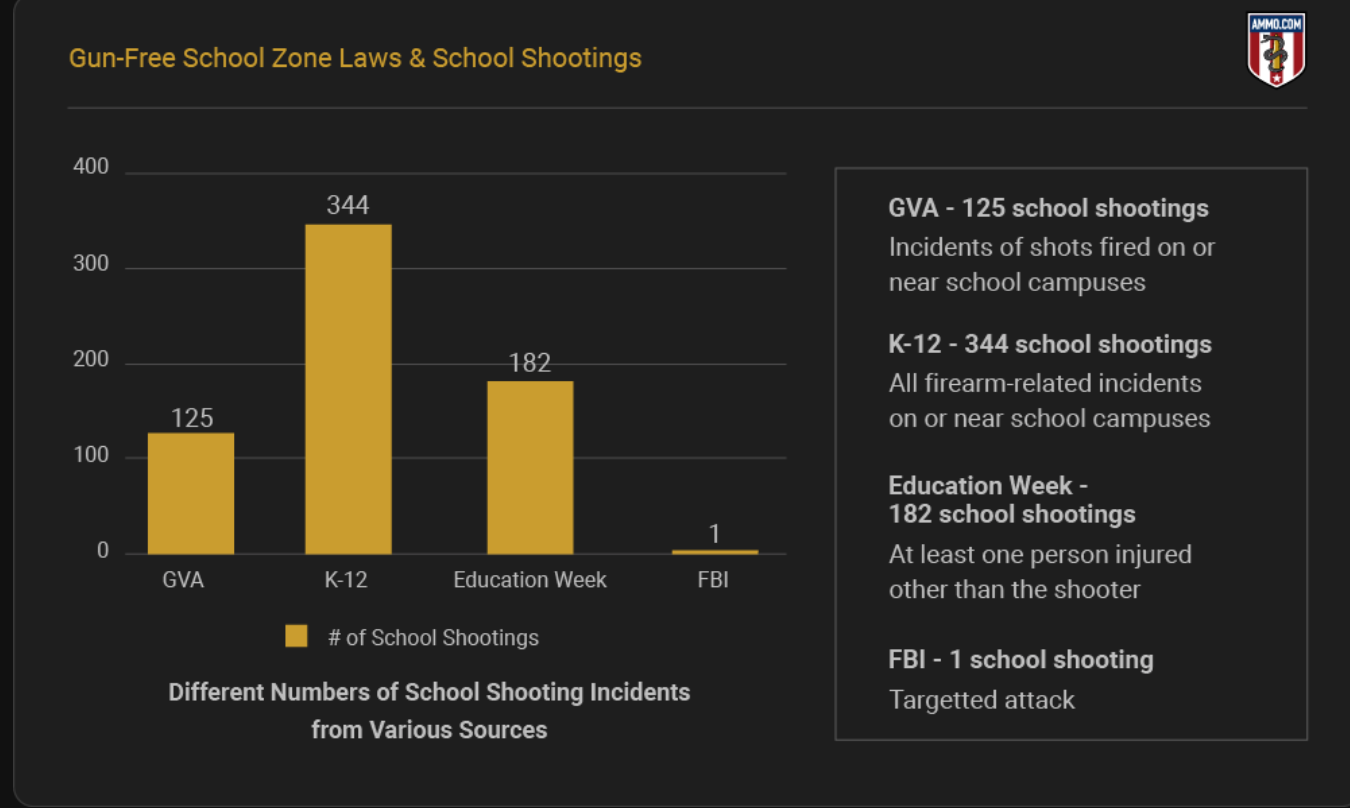
The Gun-Free School Zone Act: Explained
The Gun-Free School Zone Act (GFSA) imposed penalties for possessing or brandishing a firearm on school property, with exceptions for official capacities such as School Resource Officers (SROs).
Initially passed in 1990, the GFSA was ruled unconstitutional in Lewis v. U.S., leading Congress to pass an amended version in 1995, citing the Commerce Clause of the U.S. Constitution.
Essentially, the 1995 GFSA stated that school shootings impacted Americans’ ability to travel freely and without fear between states.
The goal of the GFSA was to deter gun-related incidents on school campuses. Unfortunately, this bill also left schools defenseless against a new threat, targeted attackers.
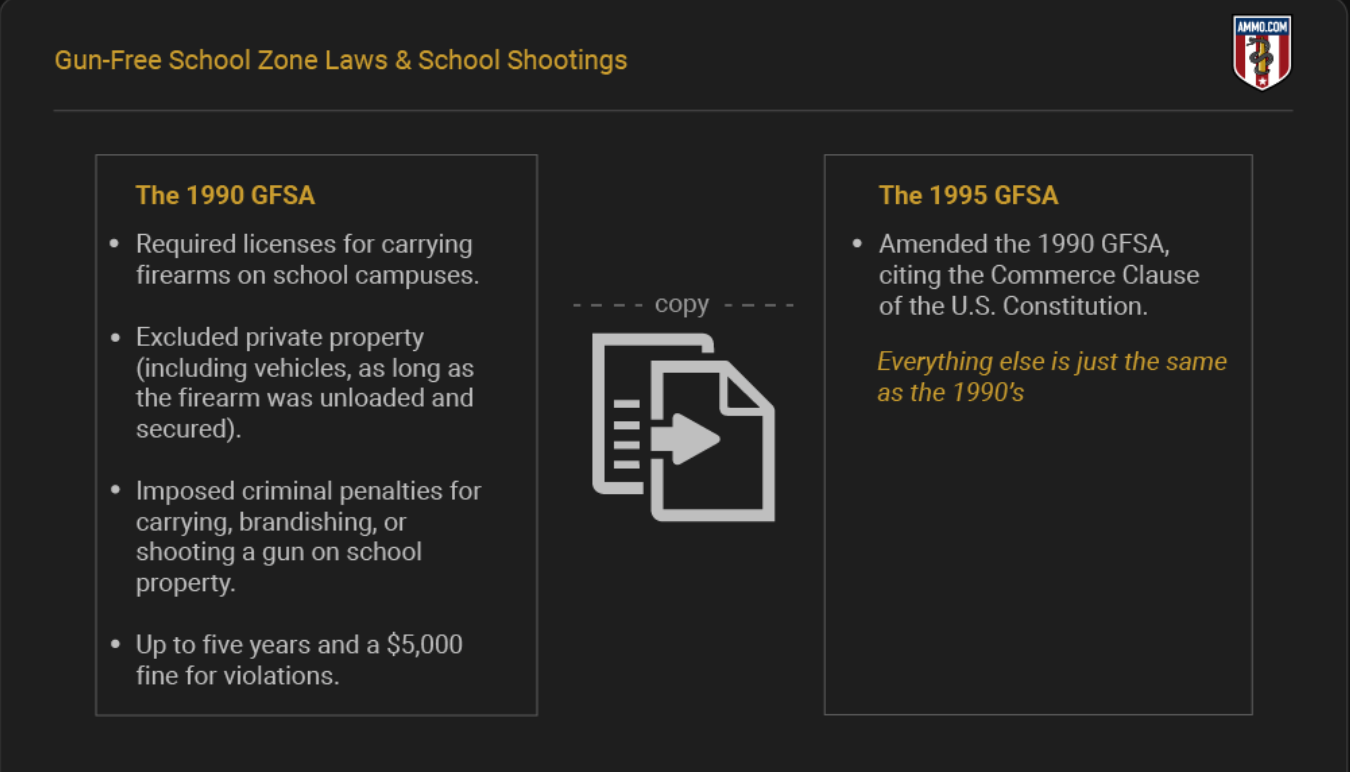
Targeted Attacks in Schools Before and After Gun-Free School Zones
Using the FBI’s definition, targeted attacks on school campuses increased by 384.6% after the GFSA was enacted. (Source 1) Between 1970-1989, there were 26 targeted attacks on schools, while 126 occurred between 1991-2000. (Source 1,7)
As defined, targeted attacks are “any incident of violence where a known or knowable attacker selects a particular target before their violent attack.” As opposed to other types of school shootings, these acts are often deadlier and more terroristic.
Targeted attackers aim to inflict maximum harm with minimal resistance. The GFSA did not prevent these incidents from happening, as the numbers indicate an increase in targeted attacks.

School Shootings: Before and After Gun-Free School Zones
Before the 1990 GFSA, only 389 recorded incidents would have violated the new rule’s intent (brandishing, shooting, threatening, etc.). After 1991, there were 1,662 incidents, a 327% increase. (Source 1)
All School Shootings: 1970-2022
Before the mid-1990s, schools weren’t required to report firearm possession. However, local newspapers and the FBI tracked such incidents when they posed a threat. To understand school shootings before and after the implementation of gun-free zones, we need to delve deeper.
The representation of school shootings is often inaccurate due to the lack of a standard definition. Here, we’ll analyze all known school shootings from 1970 to 2022 in context.
Between January 1970 and June 2022, there were 2,069 firearm-related incidents on school campuses. Of these, 62% (1,284 incidents) occurred during school hours, with 637 happening on school grounds. Among these incidents, 498 involved a shooting during school hours on school campuses.
From 1970 to 2022, there were 191 active shooting incidents on school grounds, as defined by the FBI. Additionally, 237 incidents were gang-related, and 117 were domestic disputes.
Disputes led to 720 of these school shootings. There were also 140 drive-by shootings and 96 indiscriminate shootings. Incidents related to bullying or anger over suspensions or grades accounted for 94 shootings. Thirty-six shootings were attributed to psychosis, and 14 resulted from racial tensions (11 of which occurred before the Gun-Free Schools Act).
Now, let’s examine how school shootings have evolved over time.
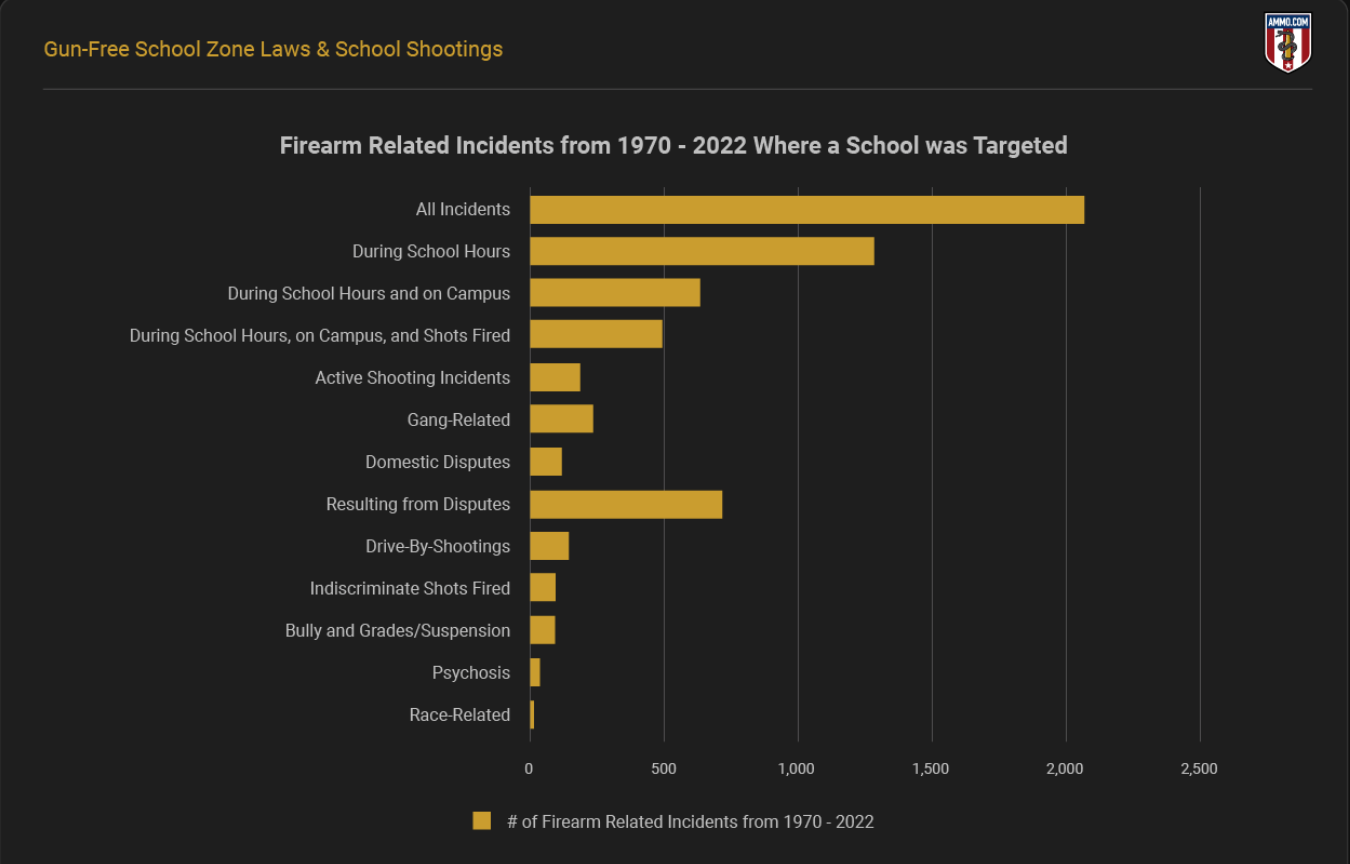
School Shootings 1970-1989
Before the GFSA, 389 firearm-related incidents were recorded on or near school campuses. While some incidents may be missing from reports, as it wasn’t required to report incidents before the GFSA, these incidents were notable enough threats to publish in newspapers or report to the FBI.
Among these, 135 occurred during school hours, 124 occurred during school hours on school campuses, and 99 involved shots fired.
There were only 11 active shootings, 10 gang-related incidents, and 10 domestic disputes. Disputes accounted for 55 incidents, while bullying and suspension issues accounted for 16 incidents. Race-related incidents were higher, with 11 incidents recorded.
Note: The following data includes only school-related shootings that occurred while students were present and on school property (unless otherwise stated).
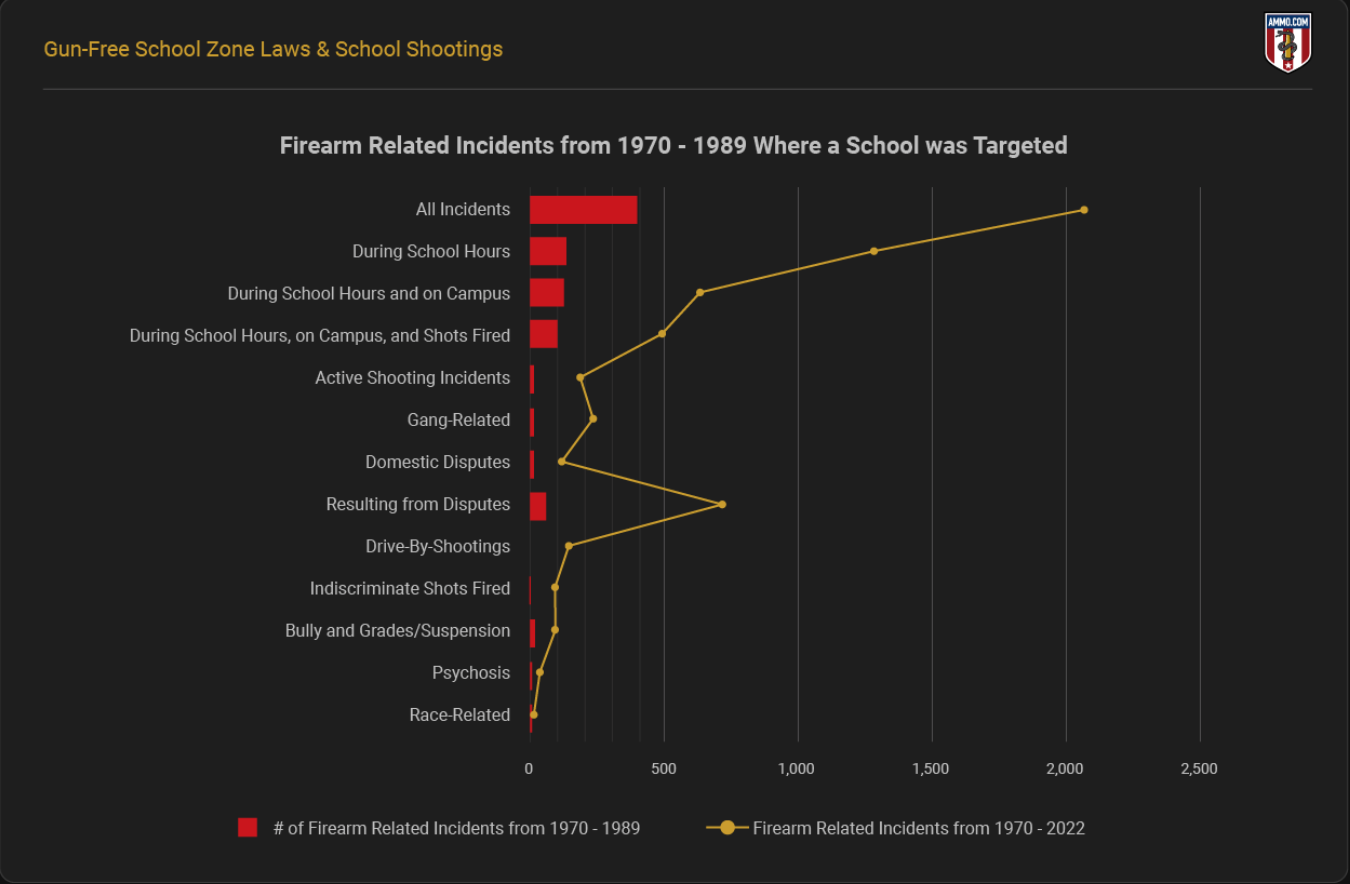
School Shootings 1991-2022
After the GFSA, 1,662 notable firearm-related incidents occurred, with 958 during school hours. Of these, 860 took place on school grounds, and 601 resulted in shots fired.
There were 68 active shootings (a 518% increase), 53 gang-related shootings, and 38 domestic disputes. Disputes led to 151 shootings, with more drive-by shootings (36) and indiscriminate shots fired (39). Bullying and suspension-related incidents led to 35 shootings, and psychosis led to 12. Race-related incidents decreased to just one.
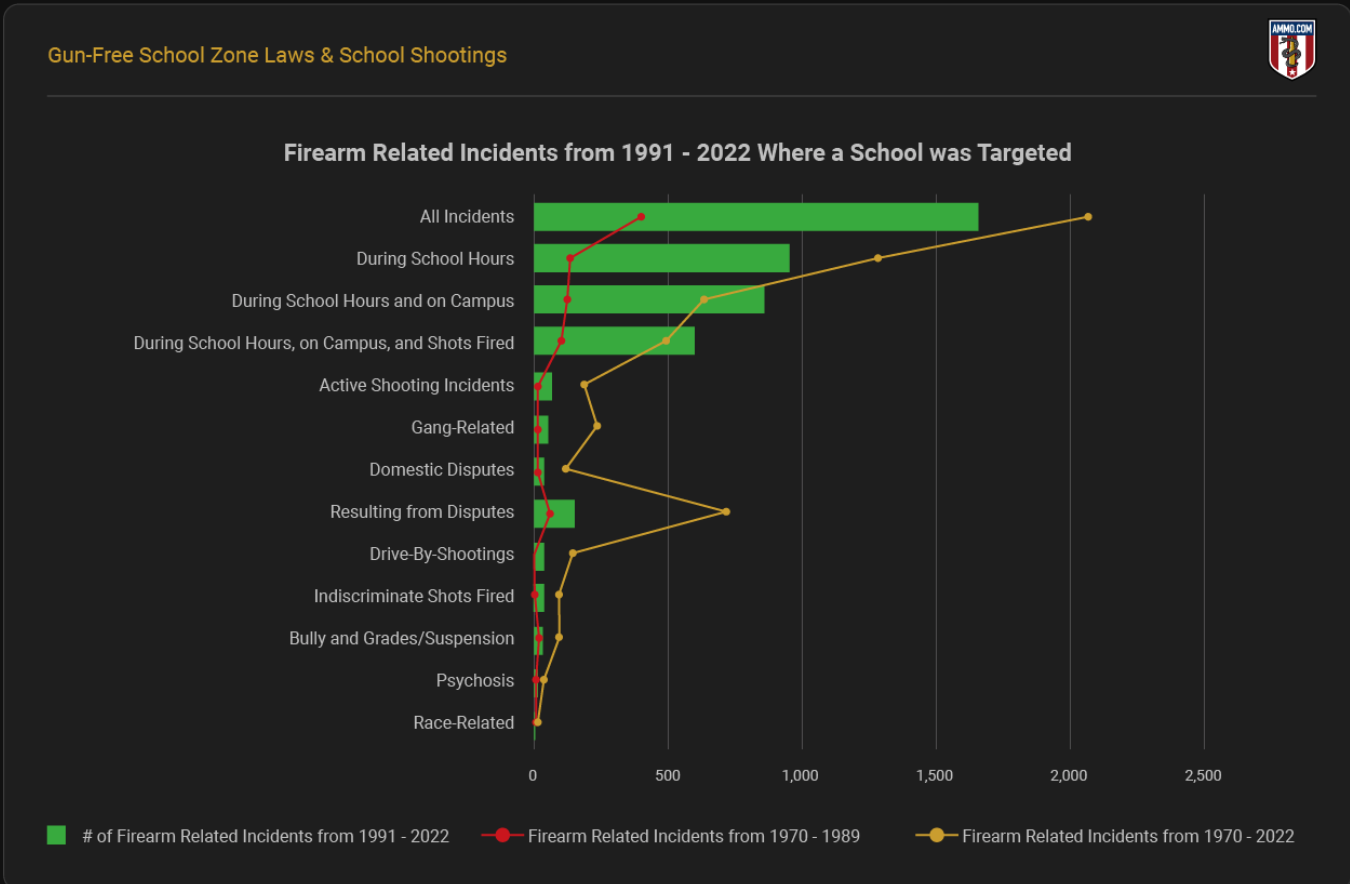
Gun-Free Schools and School Shootings: Wrap Up
School shootings began increasing after 1974, but they were relatively rare until after the 1990 GFSA. While the exact causes of school shootings are unclear, it is evident that they were less frequent before the disarmament of teachers, faculty, and students.
The GFSA failed to protect children and faculty and did not address the underlying issues leading to school shootings. Therefore, firearm restrictions alone are not effective in reducing school shootings on campuses.
Sources:
- Center for Homeland Defense and Security
- School Shootings in 2023: Fewer Injuries and Deaths While Gun Violence Continues
- S.890 Gun-Free School Zones Act of 1995
- S.2070 Gun-Free School Zones Act of 1990
- Implications for the Prevention of School Attacks in the United States
- Protecting America’s Schools: A U.S. Secret Service Analysis of Targeted School Violence
- K-12 Shooting Database
- Another Record High: Counting School Shootings in 2023
- Number of K-12 School Shootings in the U.S. from 1970 to June 2022
LegalReader thanks our friends at Ammo.com for permission to republish this article. The original is found here.

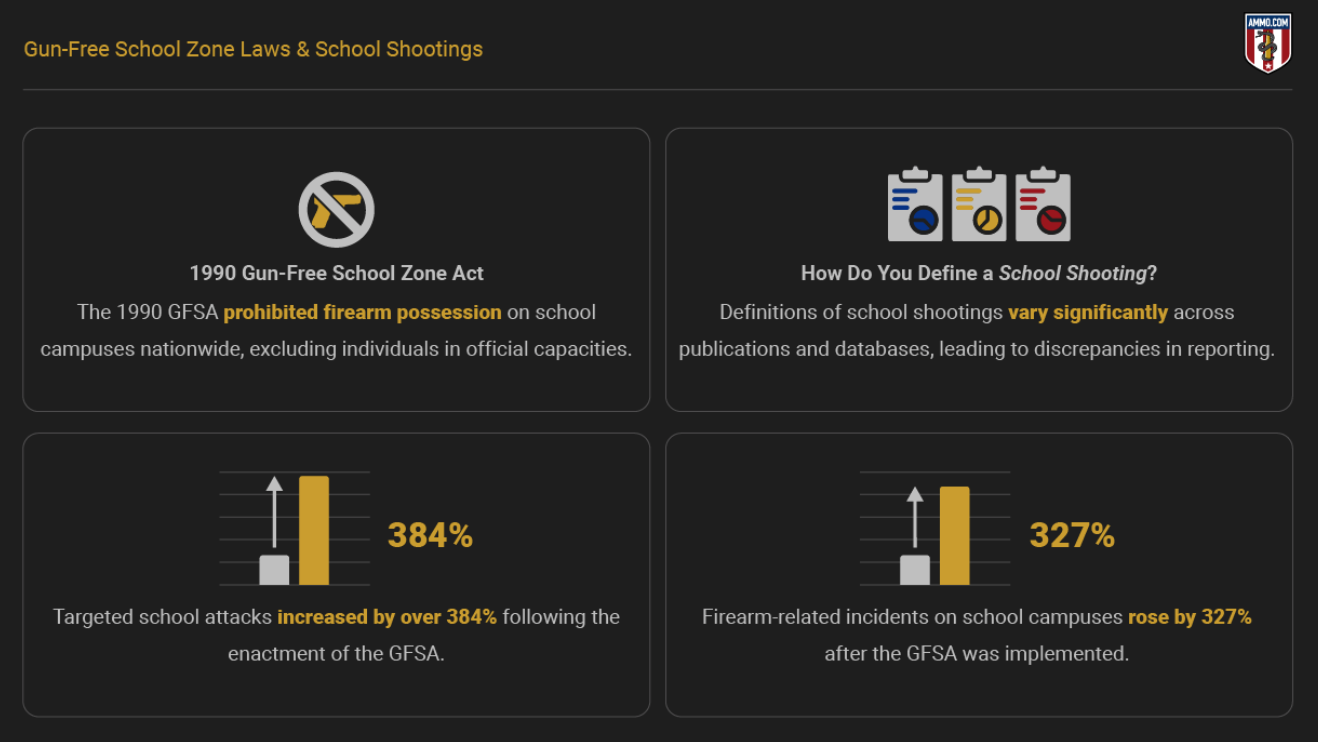
Join the conversation!